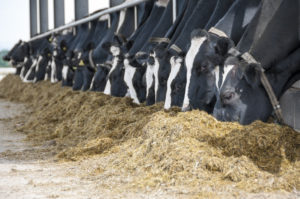Despite experiencing both droughts and floods in the same summer, feedback from customers and trends have suggested that most dairy units have achieved 3 cuts, with 4th on the way and in some cases a 5th.
Whilst a low yielding 1st cut usually points towards leafy wet silage, this year’s averages are uncharacteristically dry which will be very positive when it comes to utilising that quality. Early averages are looking positive and surprisingly consistent between cuts, apart from the usual fibre and energy variations. The importance of dry matter (DM) is often understated; it dictates clamp stability, palatability and intake characteristics. Whilst we love to see a high D-value and ME, cows must be able to keep the silage in the rumen long enough for it to be digested.
An 11.5ME+ silage looks positive on the analyses, but all too often is unachievable when the DM is less than 30%. This year’s 1st cut silage, with an average DM of 35.9%, suggests good rumen health characteristics, reduced risk of clostridia during fermentation and high milk yield potential. On a typical DM intake, this year’s average 1st cuts at 11.1ME could sustain over 11 litres, 2 litres/h/d more than a typical 3rd cut which at 10.3ME is what we would expect to see in other seasons.
The decreasing ME through the cuts follows the trend of increasing fibre (NDF), perhaps slightly more so than many were expecting; likely due to the high levels of lignin-indigestible by ruminants. For dryer silages, particularly those of high fibre and lower ME, chop silage to approximately 20mm to stimulate intake.
Rumen health characteristics are generally positive through the cuts. Sugar levels (1.8-3%) are not overly high and with relatively average lactic acid and RFC (rapidly fermentable carbohydrates), average acid loads of 47.6, 46 and 44.8, suggest that diets can be pushed if needed. Higher DM silages often lead to higher pH, which in many cases is acceptable; however, keep a close eye on clamp stability and heating at the face or through feed-out. The TMR can be treated to tackle heating but don’t delay as heat is using valuable energy and creates spoilage. To promote intakes, overall TMR DM should be 45 – 50%, higher levels will only reduce intakes. Adding water is an option to help not only stimulate intakes but can reduce sorting in very dry diets.
Published data (Felton and DeVries, 2010) and feedback from our sales specialist are mixed on the effects of dry silages; some have reported higher intakes and milk yields, whilst others have found no effects and heating in the ration. Incorporating alternative feeds such as molasses could be an appropriate step; adding moisture, increasing palatability and delivering energy.
A key and well-known driver for farm profitability is milk yield from forage, and the latest Kingshay costings report shows an improvement on a rolling 12-month basis, an increase of 246 litres/cow/year to average 2,799 litres/cow/year.
At NWF we are passionate about improving farm performance and it is being reflected; herds supported by NWF Specialists average 105 litres/cow/year more from forage than the average (2,904 litres/cow/year from forage).
For more information on maximising your livestock performance this Winter, speak to your local NWF Sales Specialist, or call 0800 756 2787 or view our Silage Additive range online HERE.

